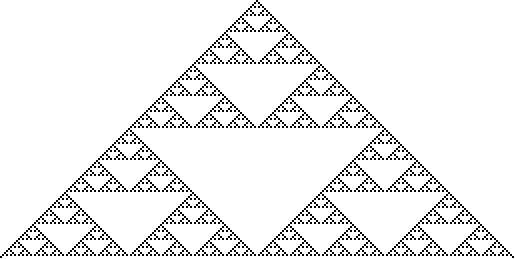謝爾賓斯基篩法是由謝爾賓斯基於 1915 年描述的一種分形,在 13 世紀的義大利藝術中就已出現 (Wolfram 2002, p. 43)。它也被稱為謝爾賓斯基墊片或謝爾賓斯基三角形。該曲線可以寫成 Lindenmayer 系統,初始字串為"FXF--FF--FF", 字串重寫 規則"F" -> "FF", "X" -> "--FXF++FXF++FXF--", 和角度  .
.
謝爾賓斯基篩法的第  次迭代在 Wolfram Language 中實現為SierpinskiMesh[n].
次迭代在 Wolfram Language 中實現為SierpinskiMesh[n].
設  為迭代
為迭代  後黑色三角形的數量,
後黑色三角形的數量, 為三角形邊的長度,
為三角形邊的長度, 為第
為第  次迭代後黑色的 面積 分數。則
次迭代後黑色的 面積 分數。則
因此,容量維度為
(OEIS A020857; Wolfram 1984; Borwein and Bailey 2003, p. 46).
謝爾賓斯基篩法由美麗的遞推方程產生
 |
(8)
|
其中  表示按位 異或。它也由下式給出
表示按位 異或。它也由下式給出
 |
(9)
|
其中  是由下式定義的第
是由下式定義的第  個最低有效位
個最低有效位
 |
(10)
|
並且乘積取遍所有滿足  的
的  (Allouche and Shallit 2003, p. 113)。
(Allouche and Shallit 2003, p. 113)。
謝爾賓斯基篩法由 帕斯卡三角形 (mod 2) 給出,給出序列 1; 1, 1; 1, 0, 1; 1, 1, 1, 1; 1, 0, 0, 0, 1; ... (OEIS A047999; 左圖)。換句話說,在帕斯卡三角形中,將所有奇數著色為黑色,將偶數著色為白色,會產生謝爾賓斯基篩法 (Guy 1990; Wolfram 2002, p. 870; 中圖)。二項式係數  mod 2 可以使用按位運算 AND(NOT(
mod 2 可以使用按位運算 AND(NOT( ),
),  ) 計算,給出序列 0; 0, 0; 0, 1, 0; 0, 0, 0, 0; 0, 1, 2, 3, 0; ... (OEIS A102037; 右圖),然後如果結果為 0 則將三角形著色為黑色,否則著色為白色。這是 盧卡斯對應定理 對於二項式係數模素數的推論。
) 計算,給出序列 0; 0, 0; 0, 1, 0; 0, 0, 0, 0; 0, 1, 2, 3, 0; ... (OEIS A102037; 右圖),然後如果結果為 0 則將三角形著色為黑色,否則著色為白色。這是 盧卡斯對應定理 對於二項式係數模素數的推論。
令人驚訝的是,基本元胞自動機規則 60、90 和 102 (當省略尾隨零時) 也產生謝爾賓斯基篩法 (Wolfram 2002, p. 870)。Wolfram (2002, pp. 931-932) 給出了大量可用於計算謝爾賓斯基篩法的演算法。
Gardner (1977) 和 Watkins (Conway 和 Guy 1996, Krížek et al. 2001) 獨立注意到,邊數為奇數的可構造多邊形的邊數由謝爾賓斯基篩法的前 32 行解釋為 二進位制數給出,給出 1, 3, 5, 15, 17, 51, 85, 255, ... (OEIS A004729, Conway 和 Guy 1996, p. 140)。換句話說,每一行都是不同費馬素數的乘積,項由二進位制計數給出。
另請參閱
混沌遊戲,
Lindenmayer 系統,
盧卡斯對應定理,
帕斯卡三角形,
規則 90,
規則 102,
謝爾賓斯基箭頭曲線,
謝爾賓斯基地毯,
謝爾賓斯基墊片圖,
俄羅斯方塊
使用 探索
參考文獻
Allouche, J.-P. 和 Shallit, J. Automatic Sequences: Theory, Applications, Generalizations. Cambridge, England: Cambridge University Press, 2003.Borwein, J. 和 Bailey, D. "Pascal's Triangle." §2.1 in Mathematics by Experiment: Plausible Reasoning in the 21st Century. Wellesley, MA: A K Peters, pp. 94-95, 2003.Bulaevsky, J. "The Sierpinski Triangle Fractal." http://ejad.best.vwh.net/java/fractals/sierpinski.shtml.Conway, J. H. 和 Guy, R. K. In The Book of Numbers. New York: Springer-Verlag, 1996.Crandall, R. 和 Pomerance, C. Prime Numbers: A Computational Perspective, 2nd ed. New York: Springer-Verlag, 2005.Crownover, R. M. Introduction to Fractals and Chaos. Sudbury, MA: Jones & Bartlett, 1995.Dickau, R. M. "Two-Dimensional L-Systems." http://mathforum.org/advanced/robertd/lsys2d.html.Dickau, R. M. "Typeset Fractals." Mathematica J. 7, 15, 1997. Dickau, R. "Sierpinski-Menger Sponge Code and Graphic." http://library.wolfram.com/infocenter/Demos/4662/.Gardner, M. "Pascal's Triangle." Ch. 15 in Mathematical Carnival: A New Round-Up of Tantalizers and Puzzles from Scientific American. New York: Vintage Books, pp. 194-207, 1977.Guy, R. K. "The Second Strong Law of Small Numbers." Math. Mag. 63, 3-20, 1990.Harris, J. W. 和 Stocker, H. "Sierpinski Gasket." §4.11.7 in Handbook of Mathematics and Computational Science. New York: Springer-Verlag, p. 115, 1998.Kabai, S. Mathematical Graphics I: Lessons in Computer Graphics Using Mathematica. Püspökladány, Hungary: Uniconstant, p. 127, 2002.Krížek, M.; Luca, F.; 和 Somer, L. 17 Lectures on Fermat Numbers: From Number Theory to Geometry. New York: Springer-Verlag, 2001.Lauwerier, H. Fractals: Endlessly Repeated Geometric Figures. Princeton, NJ: Princeton University Press, pp. 13-14, 1991.Mandelbrot, B. B. The Fractal Geometry of Nature. New York: W. H. Freeman, p. 142, 1983.Peitgen, H.-O.; Jürgens, H.; 和 Saupe, D. Chaos and Fractals: New Frontiers of Science. New York: Springer-Verlag, pp. 78-88, 1992.Peitgen, H.-O. 和 Saupe, D. (Eds.). The Science of Fractal Images. New York: Springer-Verlag, p. 282, 1988.Sierpiński, W. "Sur une courbe dont tout point est un point de ramification." C. R. A. S. 160, 302-305, 1915.Simmt, E. 和 Davis, B. "Fractal Cards: A Space for Exploration in Geometry and Discrete Mathematics." Math. Teacher 91, 102-108, 1998.Sloane, N. J. A. Sequences A004729, A020857, A047999, 和 A102037 in "The On-Line Encyclopedia of Integer Sequences."Steward, I. "Four Encounters with Sierpiński's Gasket." Math. Intel. 17, pp. 52-64, 1995.Sved, M. "Divisibility--with Visibility." Math. Intell. 10, 56-64, 1988.Wagon, S. Mathematica in Action. New York: W. H. Freeman, pp. 108 和 151-153, 1991.
Dickau, R. "Sierpinski-Menger Sponge Code and Graphic." http://library.wolfram.com/infocenter/Demos/4662/.Gardner, M. "Pascal's Triangle." Ch. 15 in Mathematical Carnival: A New Round-Up of Tantalizers and Puzzles from Scientific American. New York: Vintage Books, pp. 194-207, 1977.Guy, R. K. "The Second Strong Law of Small Numbers." Math. Mag. 63, 3-20, 1990.Harris, J. W. 和 Stocker, H. "Sierpinski Gasket." §4.11.7 in Handbook of Mathematics and Computational Science. New York: Springer-Verlag, p. 115, 1998.Kabai, S. Mathematical Graphics I: Lessons in Computer Graphics Using Mathematica. Püspökladány, Hungary: Uniconstant, p. 127, 2002.Krížek, M.; Luca, F.; 和 Somer, L. 17 Lectures on Fermat Numbers: From Number Theory to Geometry. New York: Springer-Verlag, 2001.Lauwerier, H. Fractals: Endlessly Repeated Geometric Figures. Princeton, NJ: Princeton University Press, pp. 13-14, 1991.Mandelbrot, B. B. The Fractal Geometry of Nature. New York: W. H. Freeman, p. 142, 1983.Peitgen, H.-O.; Jürgens, H.; 和 Saupe, D. Chaos and Fractals: New Frontiers of Science. New York: Springer-Verlag, pp. 78-88, 1992.Peitgen, H.-O. 和 Saupe, D. (Eds.). The Science of Fractal Images. New York: Springer-Verlag, p. 282, 1988.Sierpiński, W. "Sur une courbe dont tout point est un point de ramification." C. R. A. S. 160, 302-305, 1915.Simmt, E. 和 Davis, B. "Fractal Cards: A Space for Exploration in Geometry and Discrete Mathematics." Math. Teacher 91, 102-108, 1998.Sloane, N. J. A. Sequences A004729, A020857, A047999, 和 A102037 in "The On-Line Encyclopedia of Integer Sequences."Steward, I. "Four Encounters with Sierpiński's Gasket." Math. Intel. 17, pp. 52-64, 1995.Sved, M. "Divisibility--with Visibility." Math. Intell. 10, 56-64, 1988.Wagon, S. Mathematica in Action. New York: W. H. Freeman, pp. 108 和 151-153, 1991. Wang, P. "Renderings." http://www.ugcs.caltech.edu/~peterw/portfolio/renderings/Wolfram, S. "Computation Theory of Cellular Automata." Comm. Math. Phys. 96, 15-57, 1984.Wolfram, S. A New Kind of Science. Champaign, IL: Wolfram Media, pp. 870 和 931-932, 2002.
Wang, P. "Renderings." http://www.ugcs.caltech.edu/~peterw/portfolio/renderings/Wolfram, S. "Computation Theory of Cellular Automata." Comm. Math. Phys. 96, 15-57, 1984.Wolfram, S. A New Kind of Science. Champaign, IL: Wolfram Media, pp. 870 和 931-932, 2002.在 上引用
謝爾賓斯基篩法
請引用本文為
Weisstein, Eric W. "謝爾賓斯基篩法。" 來自 網路資源。 https://mathworld.tw/SierpinskiSieve.html
主題分類

.
次迭代在 Wolfram Language 中實現為SierpinskiMesh[n].
為迭代
後黑色三角形的數量,
為三角形邊的長度,
為第
次迭代後黑色的 面積 分數。則
表示按位 異或。它也由下式給出

是由下式定義的第
個最低有效位

的
(Allouche and Shallit 2003, p. 113)。
mod 2 可以使用按位運算 AND(NOT(
),
) 計算,給出序列 0; 0, 0; 0, 1, 0; 0, 0, 0, 0; 0, 1, 2, 3, 0; ... (OEIS A102037; 右圖),然後如果結果為 0 則將三角形著色為黑色,否則著色為白色。這是 盧卡斯對應定理 對於二項式係數模素數的推論。